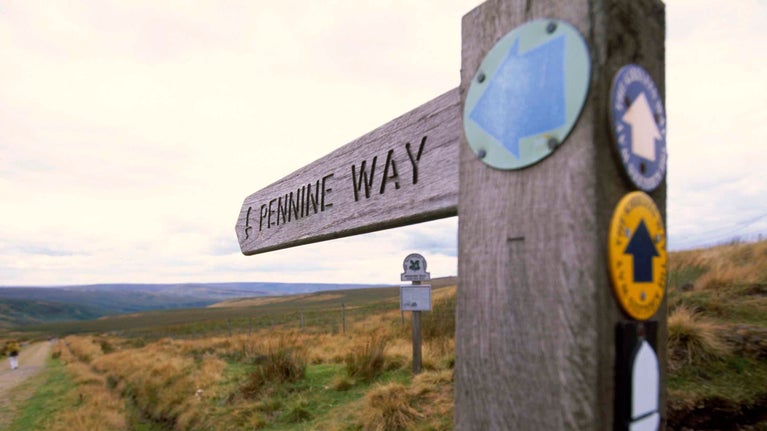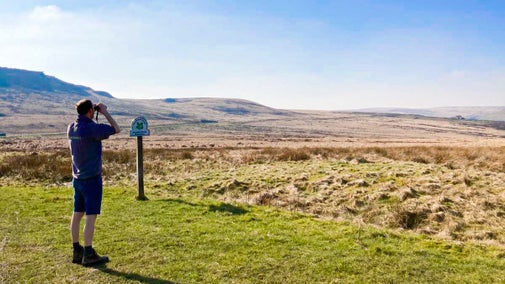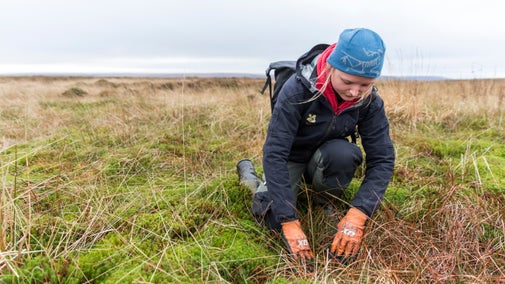
Donate
Everyone needs nature, now more than ever. Donate today and you could help people and nature to thrive at the places we care for.

We’re working hard to reverse the damage caused by more than 200 years of industrial pollution, wildfires and historic overgrazing in the Peak District and South Pennines. This vital work increases biodiversity, improves habitats for wildlife, reduces peat erosion and helps capture carbon. It also helps to re-wet the moorland, reducing the risk of both floods and fires.
Marsden Moor is a site of special scientific interest (SSSI) and a special area of conservation (SAC) because of its breeding birds and blanket bog habitat.
We carry out moorland restoration work during the autumn and winter months (September to March), outside of nesting season. Work on the open moors stops in March until August to allow birds and other wildlife to breed without too much disturbance.
During the spring and summer months we work to improve access, repair boundary fences, footpaths and stiles and help out at East Riddlesden Hall and Hardcastle Crags, which are also cared for by the National Trust.
Healthy peat can store between 30kg and 70kg of carbon per cubic metre, making it a vital tool in the fight against climate change. However, when bare peat burns it releases carbon into the atmosphere. Peat is formed where dead vegetation accumulates, rather than decays, due to a balance of high rainfall and low rates of evaporation – capturing carbon in the ground. Our work to re-establish peat-forming conditions on the moorland – which has historically been degraded by atmospheric pollution – is aimed at ensuring this carbon capturing process can continue.
To stabilise the bare peat, we use gully blocking techniques to reduce erosion and stabilise steep banks with bundles of sticks called fascines. We also plant cotton grass and sphagnum moss that we grow in our own plant nursery. These plants capture carbon and help form the peat of the future.
We're re-wetting Marsden Moor by creating hundreds of leaky dams, which help rainfall soak into the moors gradually. We also use peat dams to create small pools in flatter areas. And every winter National Trust rangers and volunteers plant hundreds of plugs of sphagnum moss, which can hold ten times its own weight in water.

We don't use controlled burning on Marsden Moor. Much of our re-wetting work helps to reduce the risk of fire as well as helping to restore peat. To try and halt the spread of fire, we use machinery to cut vegetation breaks, as well as more traditional conservation grazing.
Our re-wetting work helps to reduce flooding by making sure rainfall stays on the moors for as long as possible. Rather than water running straight off the hill, sphagnum moss and leaky dams give it time to soak in. Sphagnum moss also forms peat as well as acting as a natural flood defence.
We’re working closely with partners such as Yorkshire Water and Kirklees Council to improve natural flood management on Marsden Moor. This work is being carefully studied and recorded by our survey group, as well as academics from the University of Leeds.
We work to increase biodiversity by planting plugs of native species such as cotton grass, heather, crowberry and bilberry. This attracts a bigger range of insects, which in turn benefits the rare bird population on Marsden Moor.

We control invasive plants where we can, including purple moor grass and rhododendron. Grazing on parts of the moorland also helps with this work.
Alongside the Moors for the Future Partnership and Yorkshire Water, we're removing Rhododendron ponticum – an invasive species – from the Wessenden Valley. This plant dominates the sides of the valley and its thick leaves stop other species from growing.
Rhododendron blocks out sunlight, so the earth around it is bare. This means that when it rains, the water runs off the land quickly, taking soil and silt into the reservoirs below.
By replanting the valley with species like gorse, we’ll slow down the flow of water to the reservoirs and help to keep the water supply clean. The reintroduction of native plants will also attract more insects and birds.
We refurbish footpaths such as those on the Pennine Way to protect against the effects of erosion by foot traffic. We lay flagstones over boggy sections and add drainage features so that the surrounding peat isn't washed away during periods of wet weather.

Everyone needs nature, now more than ever. Donate today and you could help people and nature to thrive at the places we care for.
Learn how uplands are being restored with ambitious woodland creation, peatland restoration and natural flood management, by the National Trust and partners.

We’re using many different techniques to prevent further fires on Marsden Moor. Learn about why we don't use controlled burning.

Find out how you can apply to volunteer on Marsden Moor and the roles available, from helping the rangers to repair footpaths, to leading guided walks across the moorland.

Discover the abundance of wildlife on Marsden Moor, from ground-nesting birds such as golden plovers and curlews to mountain hares and even lizards.
